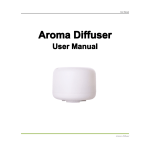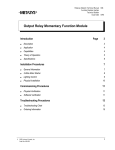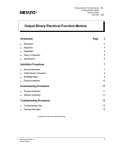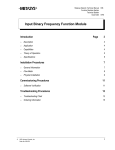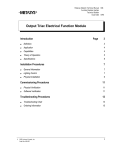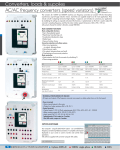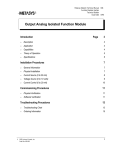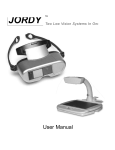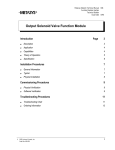Download Output Relay Electrical Function Module
Transcript
Metasys Network Technical Manual 636 Function Modules Section Technical Bulletin Issue Date 0294 Output Relay Electrical Function Module Introduction Page 3 ● Description 3 ● Application 4 ● Capabilities 4 ● Theory of Operation 5 ● Specifications *6 Installation Procedures 7 ● General Information 7 ● Motor Starter 7 ● Physical Installation 8 Commissioning Procedures 9 ● Physical Verification 9 ● Software Verification 9 Troubleshooting Procedures 11 ● Troubleshooting Chart 11 ● Ordering Information 13 * Indicates those sections where changes have occurred since the last printing. © 1994 Johnson Controls, Inc. Order No. 636-049 1 2 Function Modules—Output Relay Electrical Function Module Introduction The Output Relay Electrical (ORE) Function Module is an interface between the DCM and field devices. This function module provides on/off control of field devices. The ORE features: ● electrically maintained Form C relay and interface logic to enable the DCM to control this relay ● Hand/Off/Auto (HOA) switch for manual control ● feedback indication of the HOA switch setting to the DCM The ORE Function Module plugs into any one of the bottom ten slots associated with the DCM. Figure 1 shows typical function module locations in the NCU. A five slot panel is pictured. Output FMs DCMs I O A H O A ore101 O R E 101 Description Figure 1: ORE Function Module Locations Function Modules—Output Relay Electrical Function Module 3 Application The ORE Function Module is typically used for: ● Capabilities control of 2-wire motor starter circuits, or similar electrical equipment, so equipment fails to a known state when the DCM loses power Table 1: ORE Function Module Capabilities Capability Description Purpose Input from DCM DCM inputs a digital command. Allows DCM to provide automatic control of outputs. Hand/Off/Auto (HOA) Status Switch Switch selects one of - Auto--DCM/relay control of outputs. - Hand--Opens the Common N.C. circuit and closes the Common N.O. circuit. - Off--Opens the Common N.O. circuit and closes the Common N.C. circuit. Allows for manual override of DCM control for special situations. Allows for local/manual control, even if the DCM is not present. Note: Hand/Off positions mechanically force a contact transfer. Power on Reset At low power or after power up, relay is de-energized. Provides controlled restart. Output to Field Module provides Form C contact control. Provides contact closure control for field devices. 4 Function Modules—Output Relay Electrical Function Module Theory of Operation Figure 2 is a functional diagram of the ORE Function Module. ORE N.O. R e la y H DCM Control Electronics A COM Field Device O N.C. ore101 Figure 2: ORE Function Diagram Under DCM control, the process is: ● ● ● The DCM provides control signals to the ORE. When the relay is energized, its pair of contacts change state: The N.C. contacts open, and the N.O. contacts close. A manually controlled HOA switch can disable the DCM control of the ORE outputs, and mechanically produce either an energized (H) or de-energized (O) condition. This control is mechanical, and works even if the NCU or NEU is not powered up. The status of this switch is reported back to the DCM. Function Modules—Output Relay Electrical Function Module 5 Specifications Table 2: ORE Function Module Specifications Category Specifications For Configurations Product Code Number FM-ORE101 Output Range Two states (contact open/closed with respect to Common) on each of two leads Output Limits 1 amp, continuous Output Protection Common output fused at 3 amps with a slow blow, non-field replaceable fuse. Inrush Current 30 amps maximum Relay Type Form C relay having a Normally Open (N.O.) and Normally Closed (N.C.) contact with a common connection between them. Contacts are “break-before make” type. Relay Contact Rating 120 VAC, at 1 amp max., pilot duty Relay Insulation Resistance 1,000 M ohms (min) from contacts to coil Relay Dielectric Strength 2,000 VAC, 50/60 Hz, (for 1 minute) from contacts to coil 1,000 VAC, 50/60 Hz, (for 1 minute) between N.O. and N.C. contacts Relay Service Life Mechanical: 10,000,000 operations Electrical: 300,000 operations for inductive load at 120 VAC, at 1 amp with a power factor of 0.4 Response Time Maximum: Default Condition At low power or after power up, relay is de-energized. Source Power Power is from the PWR in the NCU/NEU. Operating Environmental Requirements 32 to 122°F (0 to 50°C) 10 to 90% noncondensing RH 86°F (30°C) maximum dew point Storage/Shipping Environmental Requirements -40 to 158°F (-40 to 70°C) 5 to 95% noncondensing RH 86°F (30°C) maximum dew point Size 0.85 in. H x 2.6 in. W x 7.0 in. L (2.2 cm H x 6.6 cm W x 17.8 cm L) Weight 0.5 lb (0.22 kg) Agency Compliance FCC Part 15 Subpart J—Class A, UL 916, CSA C22.2 No. 205 Agency Listings UL Listed and CSA Certified as part of Metasys® 6 Function Modules—Output Relay Electrical Function Module 100 msec Installation Procedures General Information When installing and connecting function modules: follow NEC and local codes ● observe maximums as specified in the specification table and in these installation guidelines ● Motor Starter Figure 3 diagrams the wiring for motor starter applications using the ORE Function Module. X1 X2 Motor Starter Holding Coil H TBF ORE R e la y N.O. 1 COM 3 N.C. 2 O v e rlo a d s O W ir e G a u g e a nd L en gth Per Local Codes A H DCM C o n t ro l E le c tr o n ic s A O C o n n e c tio n to D C M co m p le te d th r o u g h in te rn a l co n n e cto r o n e n d o f fu n ctio n m o d u le . T B F in le ft b a y o f N C U /N E U 3 6 2 5 1 4 T B F in rig h t b a y o f N C U /N E U 1 4 2 5 3 6 Strip wire and insert in side face of TBF. Use set screw in front face to secure. orew ire Figure 3: Wiring for Motor Starter Applications Function Modules—Output Relay Electrical Function Module 7 Physical Installation Assumptions The following procedure for the physical installation of the ORE Function Module assumes: ● Panel (NCU or NEU) is installed. ● Connections to field devices are complete. ● You have engineering drawings defining details for the installation. ● Procedure You are familiar with Metasys Network terminology, and the location and operation of power switches. For each ORE Function Module in the network, perform the following steps. 1. Set the HOA switch to off. 2. Refer to the engineering drawings and identify the proper panel and slot number location for this module. 3. Open latch. 4. Insert the module in the appropriate slot. 5. Close latch, locking function module in place. 8 Function Modules—Output Relay Electrical Function Module Commissioning Procedures Physical Verification Assumptions Procedure The following procedure for the physical verification of the ORE Function Module assumes: ● Physical installation at the NCU/NEU panel is complete. ● Power is available at the panel power supply, and at the field device. For each ORE Function Module in the network, perform the following steps. 1. Power up the appropriate DCM power supply. 2. Set the HOA switch to Hand. Verify that the device is activated and/or that the appropriate device is deactivated as defined in the engineering drawings. 3. Set the HOA switch to OFF. Verify that the device is activated and/or that the appropriate device is deactivated as defined in the engineering drawings. Software Verification Assumptions The following procedure for the software verification of the ORE Function Module assumes: ● ● ● Procedure Physical installation at the NCU/NEU panel is complete, including NCM, DCM, FM, etc. The operating software for the network has been downloaded to the NCM controlling the panel. An Operator Workstation is available near the panel. For each ORE Function Module in the network, perform the following steps. 1. Select the System summary that includes this ORE object. 2. Set HOA switch on the ORE to Auto. 3. Use the software override command and verify that the object’s Value attribute (as seen in the summary) matches the actual value for the field device. Function Modules—Output Relay Electrical Function Module 9 10 Function Modules—Output Relay Electrical Function Module Troubleshooting Procedures Troubleshootin g Chart Use the diagram in Figure 4 (next page) as a troubleshooting guide. It applies for failures between point objects and field devices connected through an ORE Function Module. Function Modules—Output Relay Electrical Function Module 11 Start Is the Summary containing this object displaying correct values? Yes Exit No Is Point object definition OK? No Fix definition. See Operator Workstation User's Manual . Yes Is DCM error LED off and is N2 polling and responding? No Troubleshoot DCM. See DCM 101 Technical Bulletin . Yes Is control circuit power OK? No Repair if JCI is responsible Yes Using a DVM, check FM output. Is it OK? No Yes Using a DVM, check input to field device. OK? No Replace FM. See Ordering Information ordering information. Refer to Material Return and Allowance Program, Procedure 3C2700 for information on returning defective FMs. for Troubleshoot connections and wiring. Yes Repair or replace field device if JCI is responsible. oreflow Figure 4: ORE Troubleshooting 12 Function Modules—Output Relay Electrical Function Module Ordering Information Table 3: Ordering Information Description Product Code Number ORE Function Module FM-ORE101-0 Function Modules—Output Relay Electrical Function Module 13 Notes 14 Function Modules—Output Relay Electrical Function Module Notes Function Modules—Output Relay Electrical Function Module 15 Notes Controls Group 507 E. Michigan Street P.O. Box 423 Milwaukee, WI 53201 16 Function Modules—Output Relay Electrical Function Module FAN 636 Metasys Network Technical Manual Revision Date 0194 Printed in U.S.A.
















